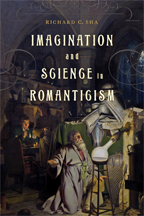
Imagination and Science in Romanticism
Richard C. Sha
John Hopkins
ISBN : 9781421439839
342 p.
34,95 $
PRÉSENTATION
Richard C. Sha argues that scientific understandings of the imagination indelibly shaped literary Romanticism. Challenging the idea that the imagination found a home only on the side of the literary, as a mental vehicle for transcending the worldly materials of the sciences, Sha shows how imagination helped to operationalize both scientific and literary discovery. Essentially, the imagination forced writers to consider the difference between what was possible and impossible while thinking about how that difference could be known.
Sha examines how the imagination functioned within physics and chemistry in Percy Bysshe Shelley's Prometheus Unbound, neurology in Blake's Vala, or The Four Zoas, physiology in Coleridge's Biographia Literaria, and obstetrics and embryology in Mary Shelley's Frankenstein. He also demonstrates how the imagination was called upon to do aesthetic and scientific work using primary examples taken from the work of scientists and philosophers Davy, Dalton, Faraday, Priestley, Kant, Mary Somerville, Oersted, Marcet, Smellie, Swedenborg, Blumenbach, Buffon, Erasmus Darwin, and Von Baer, among others.
Sha concludes that both fields benefited from thinking about how imagination could cooperate with reason—but that this partnership was impossible unless imagination's penchant for fantasy could be contained.
Richard C. Sha is a professor of literature at American University, where he is a member of the Center for Behavioral Neuroscience. He is the author of Perverse Romanticism: Aesthetics and Sexuality in Britain, 1750–1832 and the coeditor of Romanticism and the Emotions.
SOMMAIRE
Introduction
Chapter One. Imagining Dynamic Matter: Percy Shelley, Prometheus Unbound, and the Chemistry and Physics of Matter
Chapter Two. William Blake and the Neurological Imagination: Romantic Science, Nerves, and the Emergent Self
Chapter Three. The Physiological Imagination: Coleridge’s Biographia
Chapter Four. Obstetrics and Embryology: Science and Imagination in Frankenstein